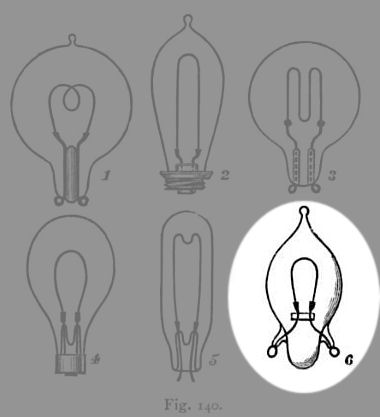X-ray
Geissler
Crookes
Radio
Box art
Dr. Hugh Hicks
S.Slabyhoudek
M-Jay
Fort Myers, FL.
Monsieur Ara
Fin Stewart
Related links
Submit a link |
|
| Akester Incandescent lamps |
|
William H. Akester is one of the lesser known names associated with incandescent lamps during the time of the early 1880s. Probably more well known for his arc lamps, the Englishman also produced incandescent lamps during the early 1880s. Below is an excerpt from an early book on the subject, not so much for the text but rather the illustration of an Akester incandescent lamp (shown in figure 6 of the illustration below).
Elementary Lessons in Electricity & Magnetism by Silvanus Phillips Thompson
|
1893 |

|
The forms of several incandescent lamps are shown in Fig. 140. Swan (1) prepares his filament from cotton thread parchmentised in sulphuric acid and afterwards carbonised; such a filament becoming remarkably elastic and metal-like in the process. Edison (2) now uses a thin flat strip of carbonised bamboo instead of a filament. Maxim (3) uses a preparation of paper. Lane-Fox (4) and Akester (6) use prepared and carbonised vegetable fibres. Crookes (5) employs a filament made from animal or vegetable matter parchmentised by treatment with cuprammonic chloride. The resistance of such lamps varies according to size and length of the filament from 3 to 200 ohms. |
|
|
Journal of the Society of Telegraph-Engineers & Electricians |
Volume XV, 1886 |
1882. W. H. AKESTER. 1642.
Improvements in Incandescent Electric Lamps.
Carbon formed by vegetable fibres being subjected to the action of an extremely concentrated solution of chloride of zinc for about two hours, at a temperature of 120° Fahrenheit; it is then washed and drawn through a die, which hardens it.
Electrodes are brought through glass at the sides instead of the middle at the bottom.
|
|
|
The historic William J. Hammer collection documents one Akester lamp from 1882 as described below, courtesy of Ed Covington's site:
- 1882-13------Akester (English). Vegetable filament, 57 volts, carbon paste clamps, double glass bridge support, brass base, tip sealed. Made in Scotland.
In the book titled "History of the Electric Lamp" (ISBN 978-0-646-23418-2) by Fin Stewart, a photo of an Akester incandescent lamp appears on page 79.
|
|
|
|











